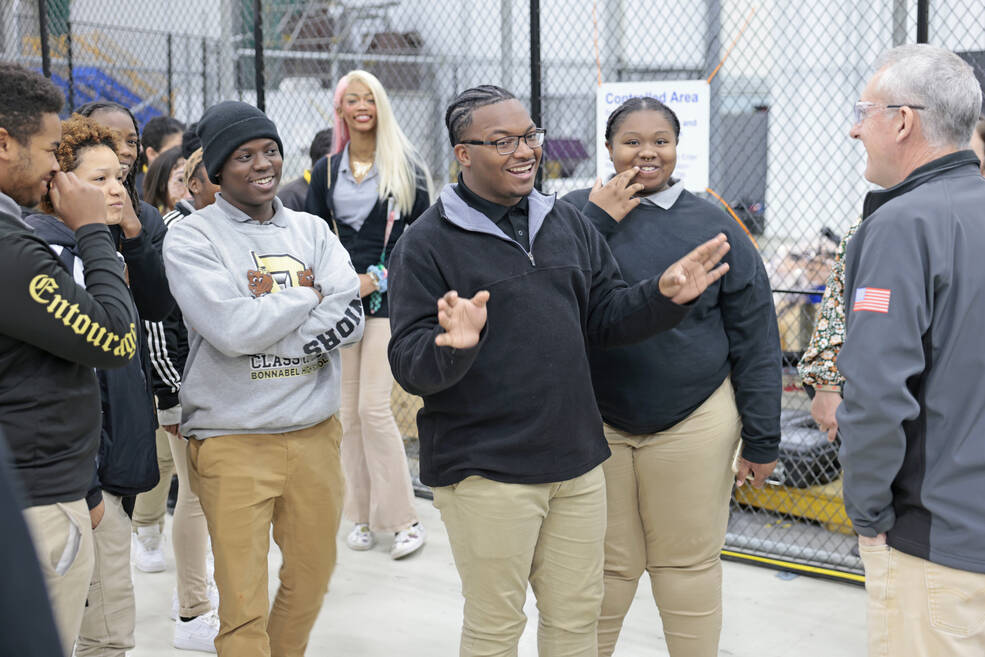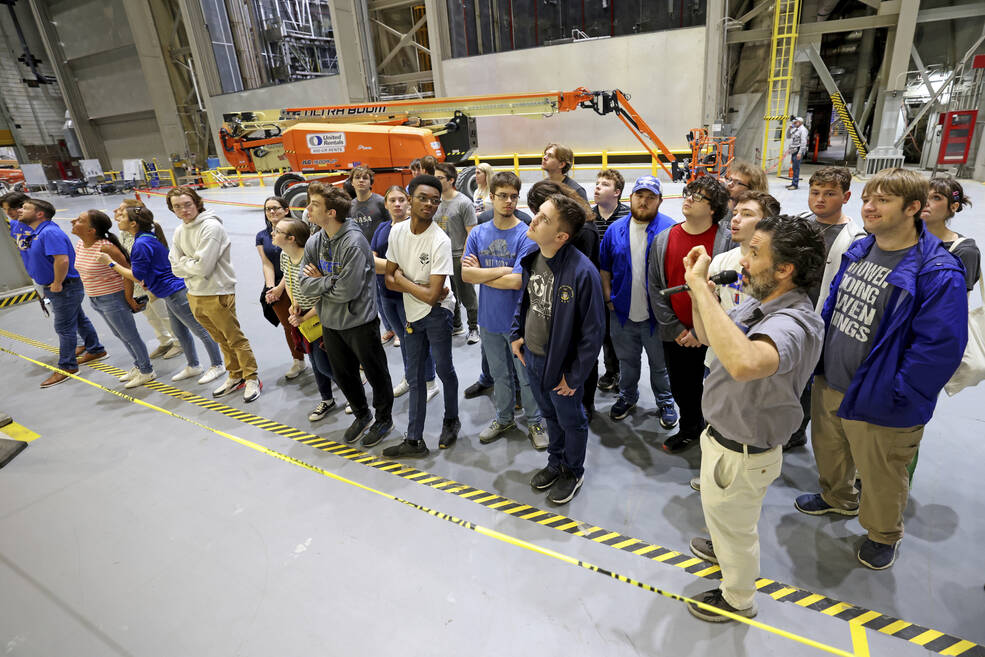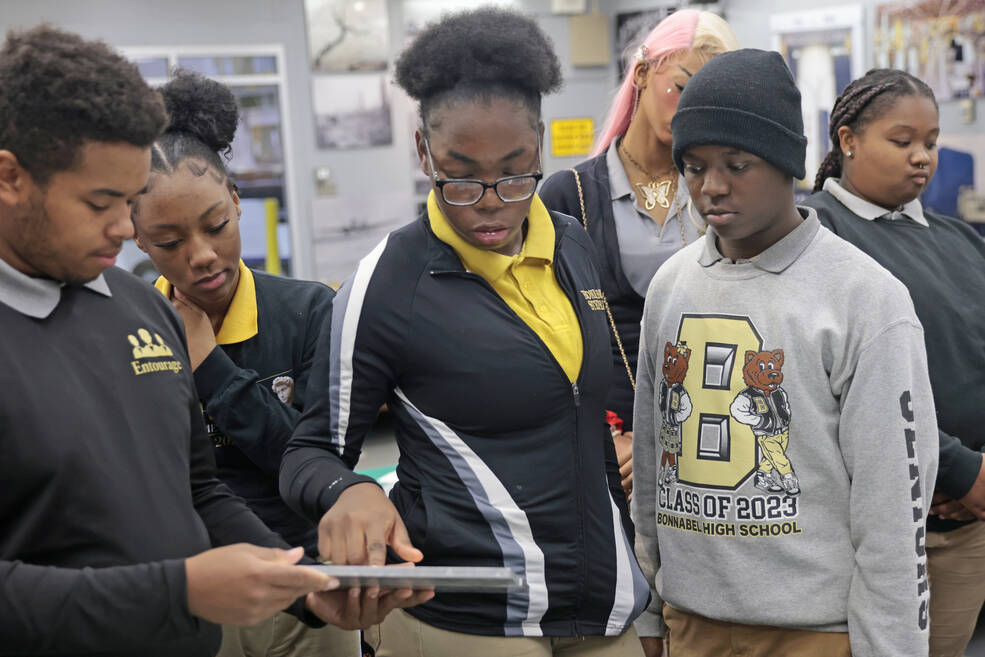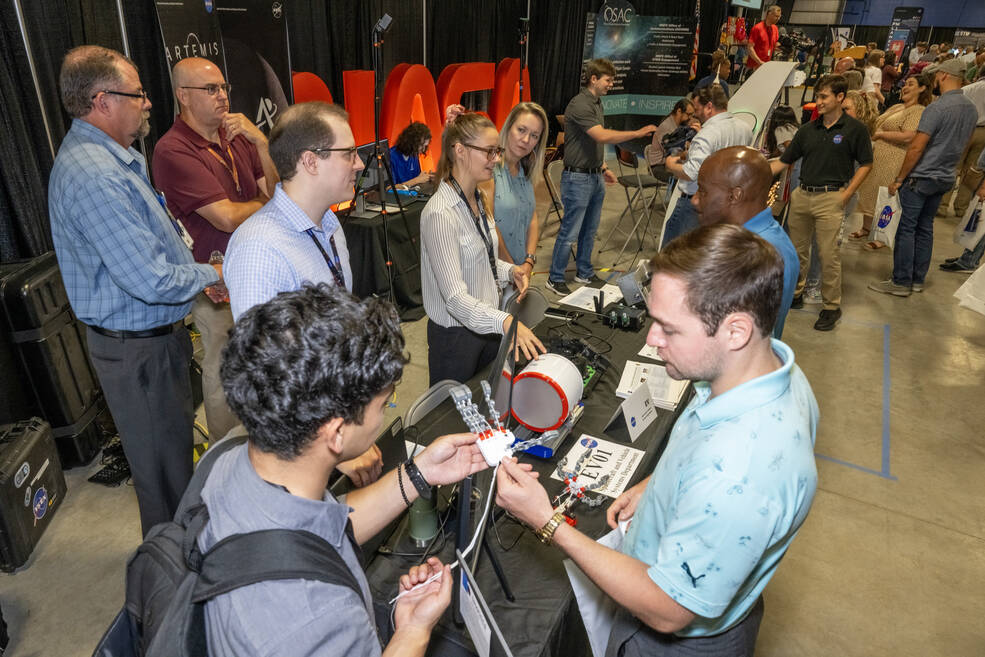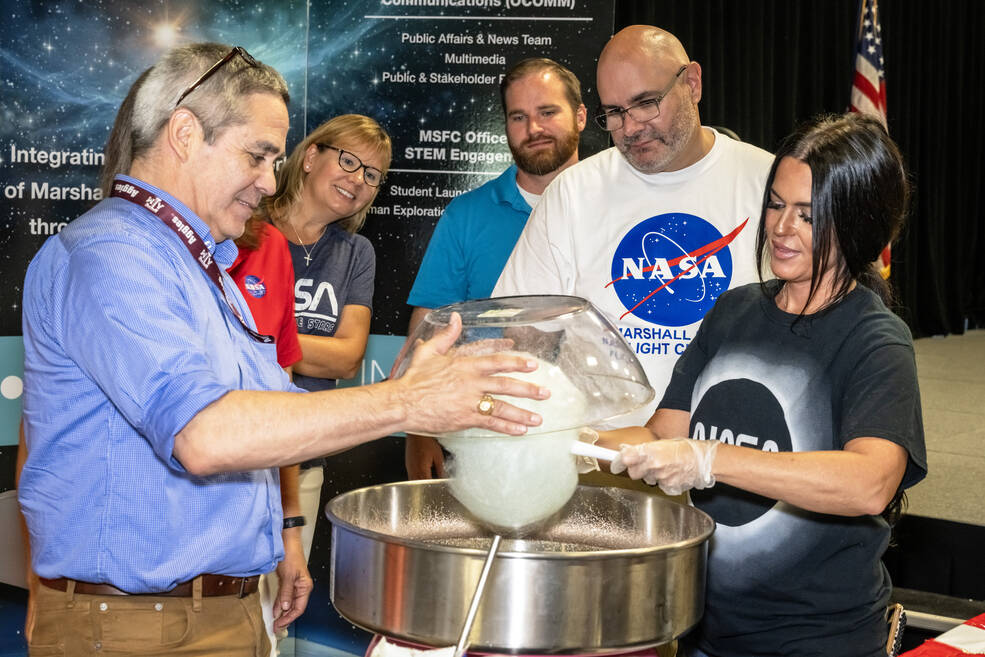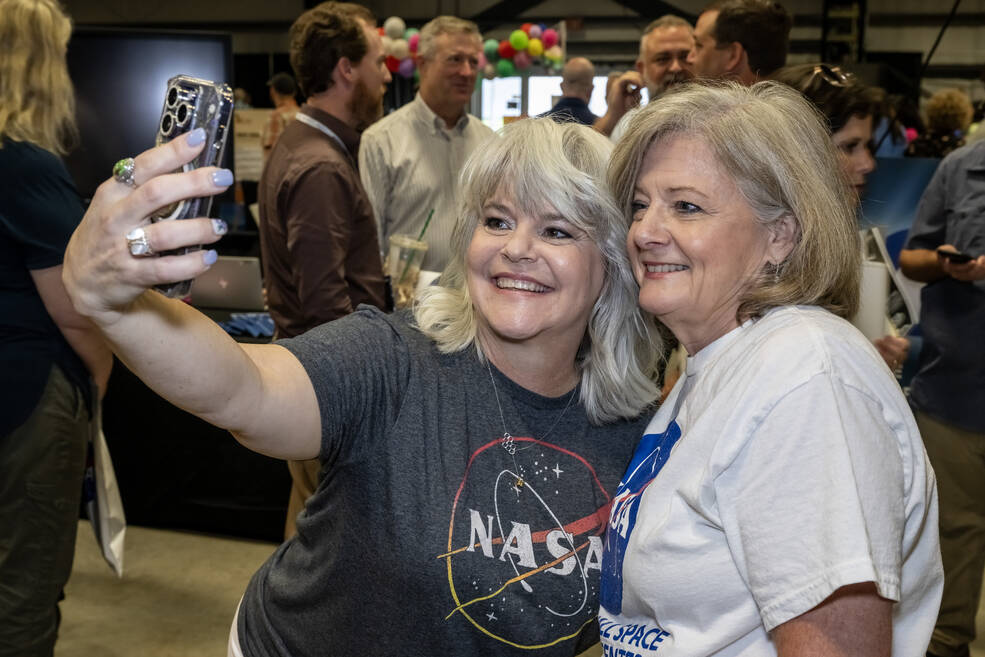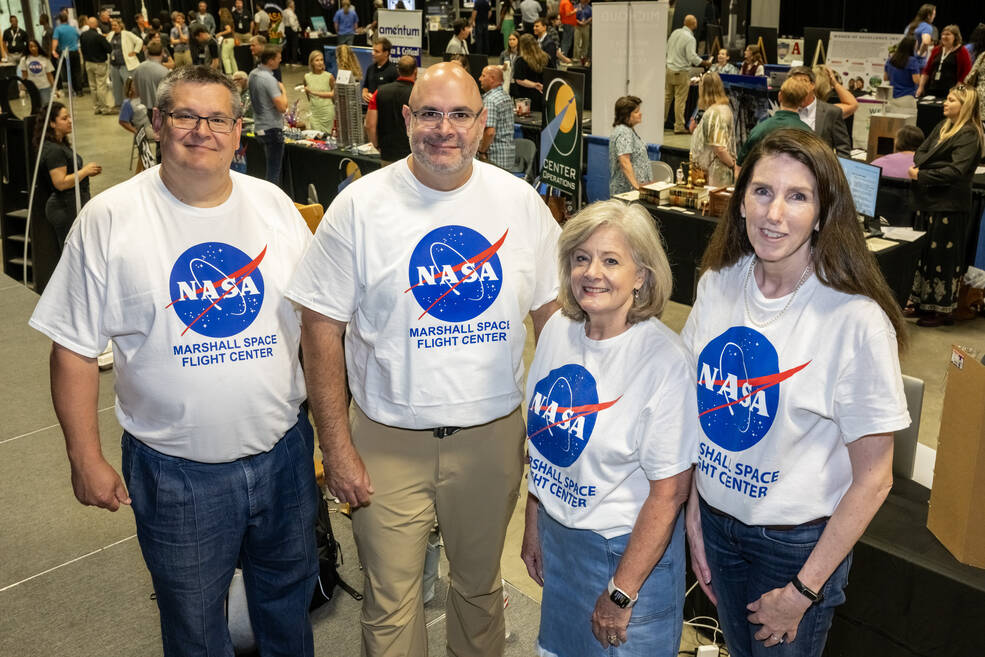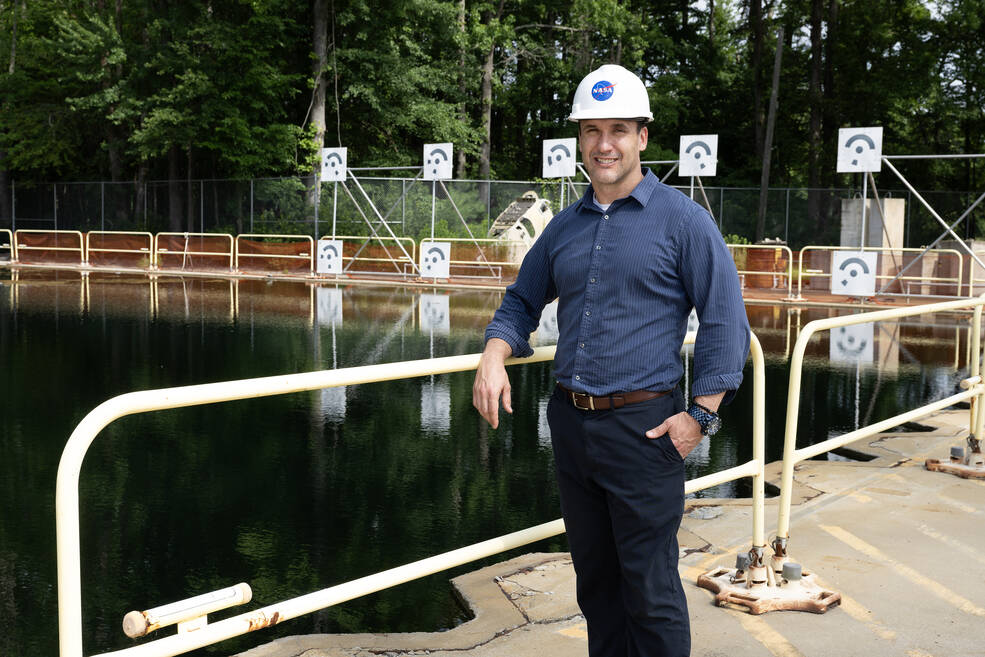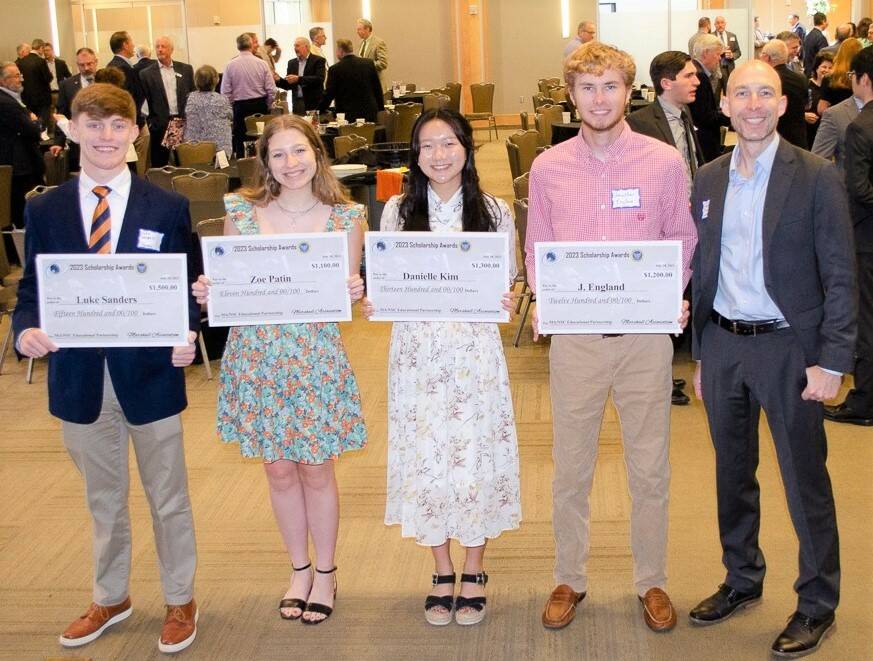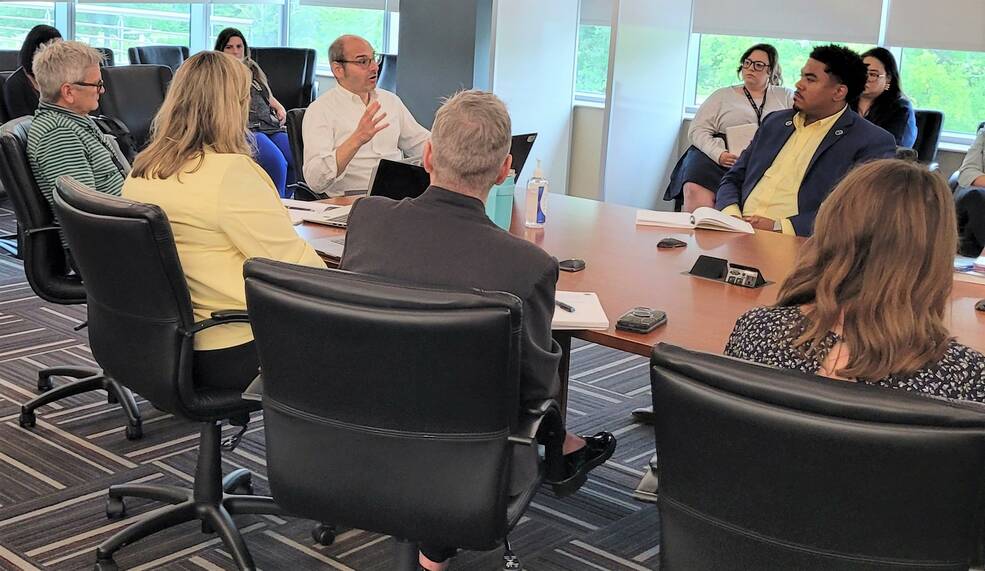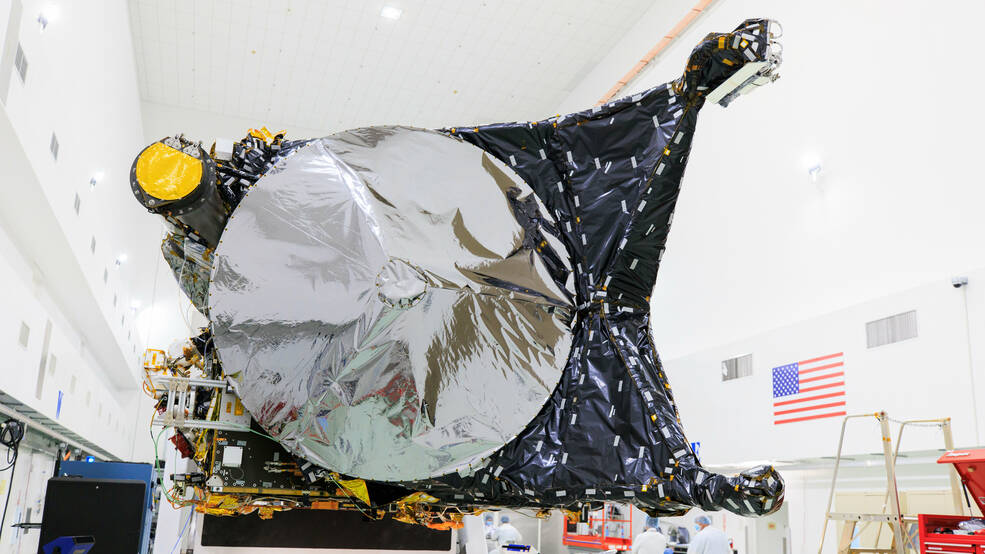The Marshall Star for July 19, 2023.
In This Week’s Star
- Michoud Serves as Vital Resource for NASA’s STEM Engagement
- Tech, Treats, and More to Explore at Marshall Showcase
- I am Artemis: Paul Kessler
- Marshall Association Recognizes 2023 Scholarship Recipients
- NASA OCOMM Leaders Visit Marshall for Town Hall
- Unexpectedly Calm and Remote Galaxy Cluster Discovered
- Psyche Mission Enters Home Stretch Before Launch
- Hubble Sees Boulders Escaping from Asteroid Dimorphos
Michoud Serves as Vital Resource for NASA’s STEM Engagement
By Matt Higgins
NASA plays a crucial part in engaging the nation’s developing workforce to enter science, technology, engineering, and math occupations of today, and the STEM jobs of the future. At the forefront of the agency’s STEM Engagement with students and educators is NASA’s Michoud Assembly Facility, which is managed by NASA’s Marshall Space Flight Center.
Michoud serves as America’s “rocket factory,” where students can witness the manufacturing and assembly of NASA’s SLS (Space Launch System) core stages and Exploration Upper Stage, and the Orion crew module, learning about the skills required for completing those tasks and the occupations that perform them.
The factory is not open to the public but special tours are available for schools and organizations on a case-by-case basis. Despite its limited access, Michoud welcomes students, educating them on SLS production, factory operations, and the higher educational institutions Michoud partners with to help develop a STEM workforce for the region.
“The students who visit Michoud are the next generation workforce. They’re the ones who are going to be the working at Michoud, long after I’m gone,” Michoud Director Lonnie Dutreix said. “That’s why we think it’s important to provide them with a STEM experience at our facility.”
NASA’s Apollo missions inspired a generation of scientists and steered many college students toward a degree in STEM. Now, through the Artemis missions, NASA is building on more than 50 years of exploration experience to explore more of the Moon than ever before with its commercial and international partners. The agency is also inspiring a new generation – the Artemis Generation – and furthering America’s demand for a skilled workforce in STEM fields.
Helping to create the next generation workforce, Michoud is partnering with local schools like Nunez Community College, just a 15-minute drive from the facility. Through these partnerships in conjunction with the Southeast Region Office of Stem Engagement at NASA’s Stennis Space Center, students complete projects that focus on SLS and Orion spacecraft production and learn about a variety of technical skills needed at Michoud, with a concentration on mechanical and electrical skills, which are critical elements of aerospace manufacturing.
During a visit to Michoud, students and educators from Live Oak High School in Denham Springs, Louisiana, had an opportunity to experience the rocket factory.
“Being able to expose our students to all the areas you could study and the possibility of being able to work here at an extraordinary facility is just incredible,” Beth Jones, principal at Live Oak High School, said.
The subject specialties of the students ran the gamut of STEM fields, and Live Oak students discovered new possible career and educational pathways from their tour.
“I’m hoping to further my education in planetary science and explore biology in space,” Haleigh Hart, a senior, said. “I didn’t know we were mining on the Moon, until today. That’s something beneficial to know for me going forward.”
Hart said it was beneficial to learn NASA will be mining on the Moon and expressed her excitement that Michoud is not far from his school.
“Getting to see that this [Michoud] is right in our backyard, I was like, ‘Whoa! We’re still in Louisiana.’ That’s really cool.”
Claiborne Plant, a junior, is focused on pursuing a career revolving around his love of math.
“My first goal is to be a math teacher. If not that, I want to work at NASA and use my math skills,” Plant said.
To further its efforts in STEM education and enhance the nation’s workforce, NASA has emphasized diversity, seeking to include more women and people of color. In support of this, Michoud is teaming up with Greater New Orleans, Inc., a regional economic development nonprofit organization that will provide 25 female high school students from its STEM summer internship program to visit Michoud.
“As our agency prepares to send the first woman and first person of color to the Moon, we want to continue attracting diverse students to STEM and providing connections to NASA’s mission,” Kevin Mcghaw, program manager for the Office of STEM Engagement at Marshall, said.
Higgins, a Manufacturing Technical Solutions Inc. employee, works in communications at Michoud Assembly Facility.
Tech, Treats, and More to Explore at Marshall Showcase
Members of NASA Marshall Space Flight Center’s Spacecraft and Vehicle Systems Department (EV) discuss their role in NASA’s mission during the Marshall Showcase, held July 24 in Activities Building 4316. The four-hour event welcomed hundreds of Marshall team members to explore and learn more about the center’s various departments and all they have to offer. For example, EV has been a major technical and engineering arm to develop vehicles and programs in the areas of Systems Engineering & Integration, flight mechanics and analysis, and structural design and analysis. (NASA/Mick Speer)
Sam Ortega, far left, and Tina Hancock, far right, prepare cotton candy at the Office of Strategic Analysis and Communications (OSAC) booth at the Marshall Showcase. Watching them work, from left, are OSAC team members Mary Duncan and Joel Wallace, and Marshall Deputy Center Director Joseph Pelfrey. (NASA/Mick Speer)
Marshall team member Leigh Martin, left, and Center Director Jody Singer pause for a selfie together at the Marshall Showcase. (NASA/Mick Speer)
Center leadership joined hundreds of Marshall team members in exploring the Marshall Showcase and seeing all the center has to offer. Pictured from left are Larry Leopard, associate director; Pelfrey; Singer; and Rae Ann Meyer, associate director. (NASA/Mick Speer)
I am Artemis: Paul Kessler
As an undergraduate student, Paul Kessler spent several years working in a Level 1 trauma center, learning about systems and processes designed to keep humans alive in extreme situations. As lead designer for NASA’s lunar surface habitat, Kessler finds he sometimes pulls on his experiences as a pre-med student when designing habitats that will sustain human life beyond low Earth orbit.
“There have been times when I’ve used my knowledge from the trauma center,” Kessler said. For example, he worked with the Exploration Medical Capability Element in NASA’s Human Research Program to develop an in-space medical room with medical supplies in easy reach. “There is some consideration in my mind for the human element.”
One of those considerations is balancing the need for an astronaut’s personal space and support systems with the need for efficiency and size limits of a cargo fairing. “This is why we’re looking into inflatable softgoods technologies, which will allow us to have more of that volume or that space inside of the habitat within a smaller fairing,” he said. “Once the habitat is launched into space, it can expand, and you can have a much bigger area to work with.”
Kessler started his university education as a pre-med student at the University of Colorado in Colorado Springs. After getting a bachelor’s degree in biology, he switched his focus to aerospace engineering, earning a master’s degree from the University of Colorado. He began his aerospace career with the Department of Defense in 2004, moving to NASA on a contract in 2008 and joining the agency as a civil servant in 2017.
At NASA’s Marshall Space Flight Center, he has worked with teams developing a lunar surface habitat and Mars transit habitat, and notes that there are significant differences in the development of each type.
“When you’re in space, you can use volume a lot more effectively than on the surface because you can get into areas that you wouldn’t normally be able to without a ladder or something like that. But on a surface habitat, floor space matters more.
“There are a lot more capabilities in terms of how you can do the layout and optimize the area that you can use, if you’re in space versus on the surface.
“The ability to maximize volume is important when you’re looking at the additional systems and supplies needed for a long, in-space mission versus a shorter stay on the lunar surface.”
Kessler also added microgravity makes it easier to move heavy things around in space. “If you’re on the surface, you must use lifting devices that you may not need to have as much in space because you can move, literally, a ton of stuff with your bare hands.”
Marshall Association Recognizes 2023 Scholarship Recipients
From left, Luke Sanders, Zoe Patin, Danielle Kim, and Jonathon England display their scholarship awards from the Marshall Association along with Gabriel Swiney, senior policy adviser in NASA’s Office of Technology, Policy, and Strategy. The Marshall Association recognized its 2023 Scholarship Recipients at the National Space Club Breakfast on July 18. Not pictured is Sachi Ramachandran, who received a $1,200 scholarship. These recipients were selected based on academic performance, letters of recommendation, involvement in extracurricular activities, and written essay submissions. The association’s scholarships are awarded to individuals pursuing degrees in undergraduate studies in both technical and non-technical fields, and range in value from $1,000 to $1,500. All recipients are either a senior in high school or a freshman/sophomore in college at the time of application and currently attend, or plan to attend, an accredited two-year or four-year institution in the United States. The recipients were chosen by a selection committee appointed by the Marshall Association Board of Officers. The Marshall Association is a professional employee service organization that includes civil service employees, retirees, and contractors of NASA’s Marshall Space Flight Center. For more information on the Marshall Association and how to join, Marshall team members can visit Inside Marshall. (National Space Club/Stephanie Robertson)
NASA OCOMM Leaders Visit Marshall for Town Hall
Johnny Stephenson, far left, deputy associate administrator for NASA’s Office of Communications (OCOMM), listens, as OCOMM Associate Administrator Marc Etkind, center, talks with NASA’s Marshall Space Flight Center OCOMM team members July 19. Etkind and Stephenson visited the center to participate in a Marshall OCOMM Town Hall, where they discussed several topics, including the best way to communicate NASA missions of exploring the universe for the benefit of all. Etkind and Stephenson also toured Marshall, including the center’s new TV studio. (NASA/Wayne Smith)
Unexpectedly Calm and Remote Galaxy Cluster Discovered
The discovery of the most distant galaxy cluster with a specific important trait – as described in a Chandra press release – is providing insight into how these gigantic structures formed and why the universe looks like it does in the present day.
This composite image shows SPT-CL J2215-3537 (SPT2215 for short) in X-rays from NASA’s Chandra X-ray Observatory (blue) and a combination of ultraviolet, optical, and infrared light from NASA’s Hubble Space Telescope (cyan and orange). Astronomers used Chandra to find this distant and unusually young galaxy cluster, along with NSF/DOE’s South Pole Telescope, the Dark Energy Survey project in Chile and NASA’s Spitzer Observatory. The results have been reported in a series of three papers.
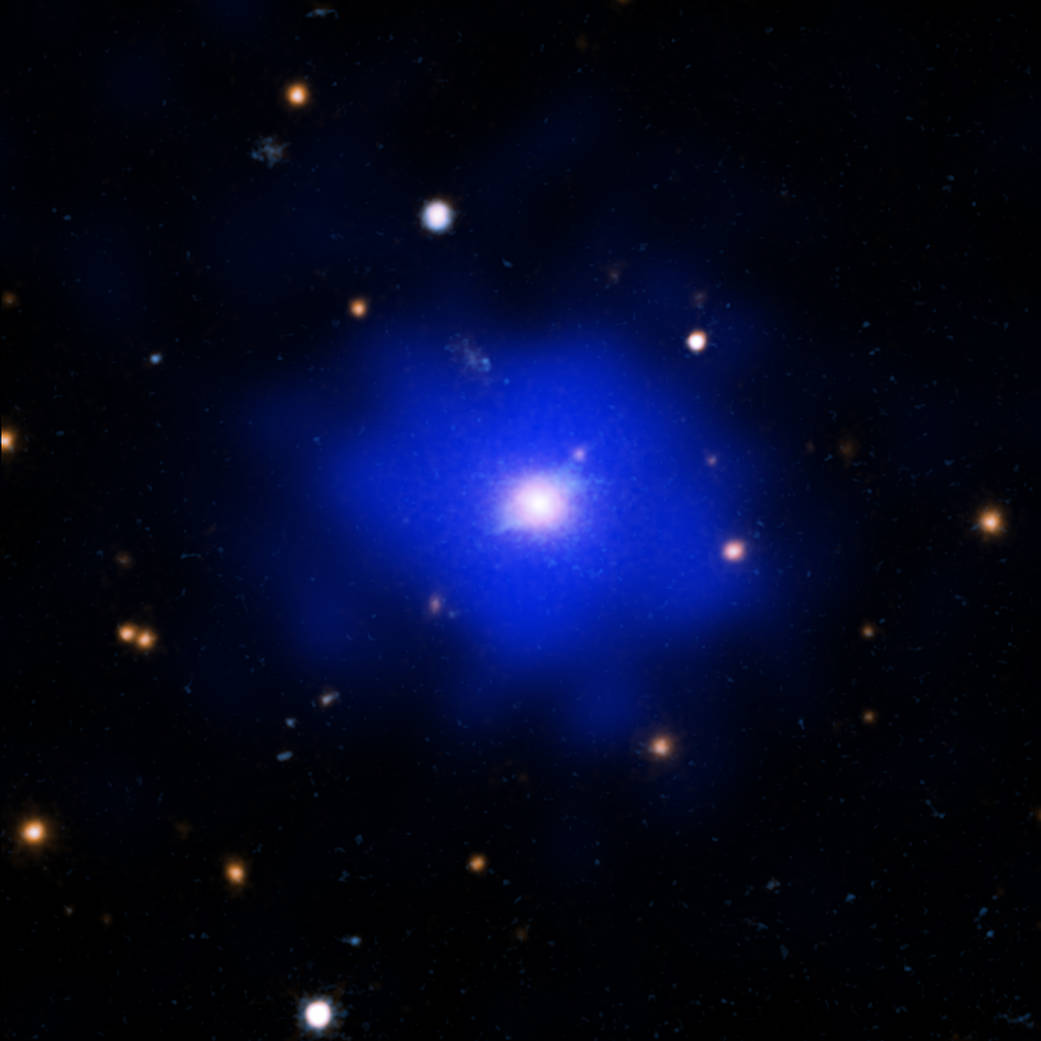
SPT2215 is located about 8.4 billion light-years from Earth. This means it is seen when the universe is only 5.3 billion years old, compared to its current age of 13.8 billion years. While there have been many clusters seen at this large distance, SPT2215 possesses a quality that makes its whereabouts particularly intriguing. SPT is what astronomers refer to as “relaxed,” meaning that it shows no signs of having been disrupted by violent collisions with other clusters of galaxies.
Galaxy clusters – some of the biggest structures in the universe — grow over time by merging with other galaxy clusters or groups, causing disturbances such as asymmetries or sharp features in the cluster’s gas. Given enough time to “relax,” however, the gas can take on a smooth, calm appearance, as seen with SPT2215. Until the identification of SPT2215, astronomers had not found a relaxed galaxy cluster this far away. In fact, scientists were not sure they would find a galaxy cluster that was relaxed at this epoch of the universe, because they are usually still undergoing the turmoil of mergers with other clusters or groups of galaxies as they increase in size.
Another interesting aspect of SPT2215 is the evidence for large amounts of star formation happening in its center. SPT2215 has a very large galaxy in its middle, which in turn has a supermassive black hole at its core. The prodigious amount of star formation shows scientists that much of the hot has cooled to the point where new stars can form, without outbursts driven by the black hole providing a heating source that prevents most of this cooling. This addresses an ongoing question of how much black holes stymie or support the birth of stars in their environments.
The central galaxy in SPT2215 is also quite isolated, with no other galaxies within about 600,000 light-years that are anywhere near as bright or extended. This implies that the cluster has not experienced a merger with another cluster in about the last billion years, giving another piece of evidence that SPT2215 is relaxed.
The three papers on SPT2215, in reverse order of publication, were a recent paper led by Michael Calzadilla and his colleagues published in the April 20, 2023 issue of The Astrophysical Journal; a paper led by Adam Mantz published in the February 2022 issue of Monthly Notices of the Royal Astronomical Society (a preprint is available online) and a paper led by Lindsay Bleem et al. published in the March 2020 issue of The Astrophysical Journal Supplement Series.
NASA’s Marshall Space Flight Center manages the Chandra program. The Smithsonian Astrophysical Observatory’s Chandra X-ray Center controls science operations from Cambridge, Massachusetts, and flight operations from Burlington, Massachusetts.
Psyche Mission Enters Home Stretch Before Launch
With less than 100 days to go before its Oct. 5 launch, NASA’s Psyche spacecraft is undergoing final preparations at Cape Canaveral. Teams of engineers and technicians are working almost around the clock to ensure the orbiter is ready to journey 2.5 billion miles to a metal-rich asteroid that may tell us more about planetary cores and how planets form.
The mission team recently completed a comprehensive test campaign of the flight software and installed it on the spacecraft, clearing the hurdle that kept Psyche from making its original 2022 launch date.
“The team and I are now counting down the days to launch,” said Henry Stone, Psyche’s project manager at NASA’s Jet Propulsion Laboratory. “Our focus has shifted to safely completing the final mechanical closeout of the spacecraft and preparing the team for operations. The team is conducting numerous training activities to ensure that we are prepared and ready. It’s a very busy time, but everyone is very excited and looking forward to the launch.”
Psyche is set to launch atop a SpaceX Falcon Heavy (the first interplanetary launch for that rocket) from Space Launch Complex 39A at Kennedy Space Center at 9:38 a.m. CDT on Oct. 5, with additional opportunities scheduled through Oct. 25. After escaping Earth’s gravity, the Psyche spacecraft will use solar electric propulsion to accomplish its six-year journey to asteroid Psyche.
Measuring about 173 miles at its widest point, the asteroid Psyche presents a unique opportunity to explore a metal-rich body that may be part of a core of a planetesimal, the building block of an early planet. Once the spacecraft reaches Psyche in the main asteroid belt between Mars and Jupiter, it will spend at least 26 months orbiting the asteroid, gathering images and other data that will tell scientists more about its history and what it is made of.
But first, a team of 30 or so engineers and technicians will wrap up the assembly, test, and launch operations phase of the mission. The team recently finished several weeks of functional testing of the science instruments as well as the spacecraft hardware and software.
After removing the last of the cables that snake around the hardware for testing, they’ll “close out” the spacecraft by reinstalling some exterior panels that had been removed for access and complete the thermal blanketing. Later in July, they will integrate and test the deployment of the enormous solar arrays. Then, in mid-August, a crew will begin slowly loading all 2,392 pounds of propellant – the neutral gas xenon – onto the spacecraft over the course of a couple weeks.
Luis Dominguez, the systems and electrical lead for assembly, test, and launch operations, is usually based at JPL but has been working full time at the Cape since early June. “We are moving forward,” he said, “and we’re confident that when we’re on the pad, we’ll be ready to hit the button. For all of us, we’ll be excited to launch this bird.”
Arizona State University leads the Psyche mission. A division of Caltech in Pasadena, JPL is responsible for the mission’s overall management, system engineering, integration and test, and mission operations. Maxar Technologies in Palo Alto, California, provided the high-power solar electric propulsion spacecraft chassis.
JPL also is providing a technology demonstration instrument called Deep Space Optical Communications that will fly on Psyche in order to test high-data-rate laser communications that could be used by future NASA missions.
Psyche is the 14th mission selected as part of NASA’s Discovery Program, managed by the agency’s Marshall Space Flight Center.
Hubble Sees Boulders Escaping from Asteroid Dimorphos
The popular 1954 rock song “Shake, Rattle and Roll,” could be the theme music for the Hubble Space Telescope’s latest discovery about what is happening to the asteroid Dimorphos in the aftermath of NASA’s DART (Double Asteroid Redirection Test) experiment. DART intentionally impacted Dimorphos on September 26, 2022, slightly changing the trajectory of its orbit around the larger asteroid Didymos.
Astronomers using Hubble’s extraordinary sensitivity have discovered a swarm of boulders that were possibly shaken off the asteroid when NASA deliberately slammed the half-ton DART impactor spacecraft into Dimorphos at approximately 14,000 miles per hour.
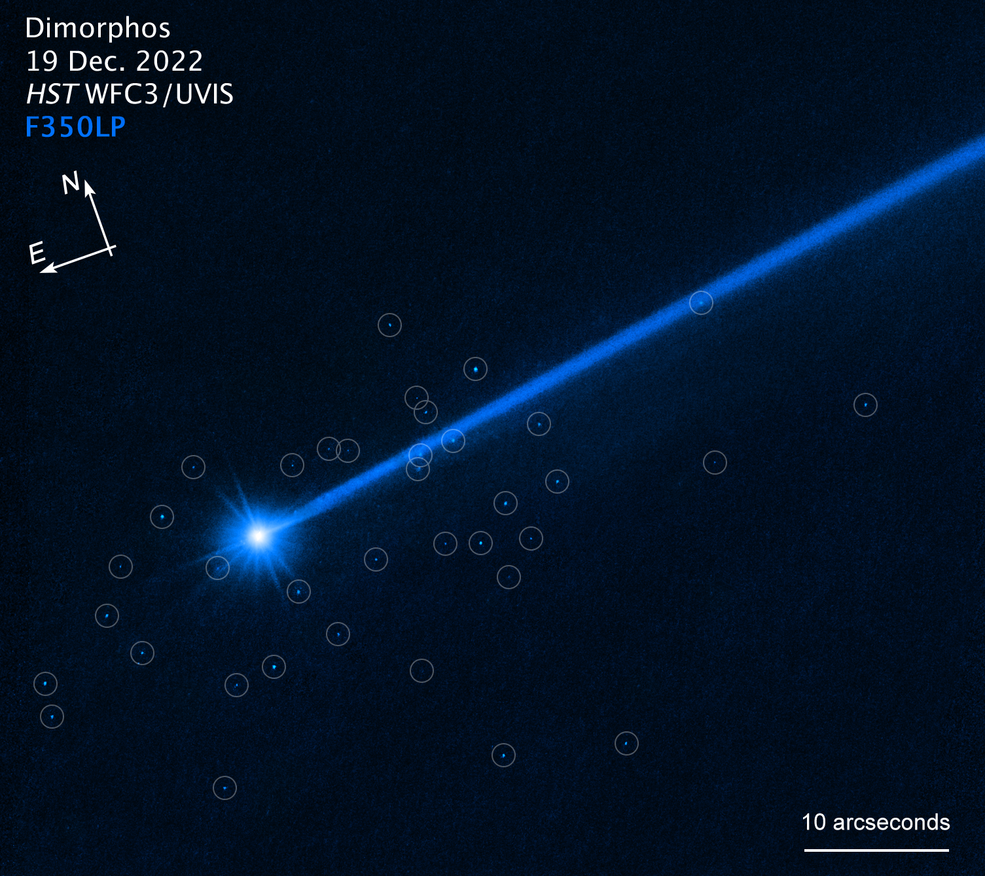
The 37 free-flung boulders range in size from three feet to 22 feet across, based on Hubble photometry. They are drifting away from the asteroid at little more than a half-mile per hour – roughly the walking speed of a giant tortoise. The total mass in these detected boulders is about 0.1% the mass of Dimorphos.
“This is a spectacular observation – much better than I expected. We see a cloud of boulders carrying mass and energy away from the impact target. The numbers, sizes, and shapes of the boulders are consistent with them having been knocked off the surface of Dimorphos by the impact,” said David Jewitt of the University of California at Los Angeles, a planetary scientist who has been using Hubble to track changes in the asteroid during and after the DART impact. “This tells us for the first time what happens when you hit an asteroid and see material coming out up to the largest sizes. The boulders are some of the faintest things ever imaged inside our solar system.”
Jewitt says that this opens up a new dimension for studying the aftermath of the DART experiment using the European Space Agency’s upcoming Hera spacecraft, which will arrive at the binary asteroid in late 2026. Hera will perform a detailed post-impact survey of the targeted asteroid. “The boulder cloud will still be dispersing when Hera arrives,” said Jewitt. “It’s like a very slowly expanding swarm of bees that eventually will spread along the binary pair’s orbit around the Sun.”
The boulders are most likely not shattered pieces of the diminutive asteroid caused by the impact. They were already scattered across the asteroid’s surface, as evident in the last close-up picture taken by the DART spacecraft just two seconds before collision, when it was only seven miles above the surface.
Jewitt estimates that the impact shook off two percent of the boulders on the asteroid’s surface. He says the boulder observations by Hubble also give an estimate for the size of the DART impact crater. “The boulders could have been excavated from a circle of about 160 feet across (the width of a football field) on the surface of Dimorphos,” he said. Hera will eventually determine the actual crater size.
Long ago, Dimorphos may have formed from material shed into space by the larger asteroid Didymos. The parent body may have spun up too quickly or could have lost material from a glancing collision with another object, among other scenarios. The ejected material formed a ring that gravitationally coalesced to form Dimorphos. This would make it a flying rubble pile of rocky debris loosely held together by a relatively weak pull of gravity. Therefore, the interior is probably not solid, but has a structure more like a bunch of grapes.
It’s not clear how the boulders were lifted off the asteroid’s surface. They could be part of an ejecta plume that was photographed by Hubble and other observatories. Or a seismic wave from the impact may have rattled through the asteroid – like hitting a bell with a hammer – shaking lose the surface rubble.
“If we follow the boulders in future Hubble observations, then we may have enough data to pin down the boulders’ precise trajectories. And then we’ll see in which directions they were launched from the surface,” said Jewitt.
The DART and LICIACube (Light Italian CubeSat for Imaging of Asteroids) teams have also been studying boulders detected in images taken by LICIACube’s LUKE (LICIACube Unit Key Explorer) camera in the minutes immediately following DART’s kinetic impact.
The Hubble Space Telescope is a project of international cooperation between NASA and ESA. NASA’s Goddard Space Flight Center manages the telescope. The Space Telescope Science Institute (STScI) in Baltimore, Maryland, conducts Hubble and Webb science operations. STScI is operated for NASA by the Association of Universities for Research in Astronomy, in Washington, D.C. NASA’s Marshall Space Flight Center was the lead field center for the design, development, and construction of the space telescope.
Johns Hopkins Applied Physics Laboratory built and operated the DART spacecraft and manages the DART mission for NASA’s Planetary Defense Coordination Office as a project of the agency’s Planetary Missions Program Office, which is at Marshall.


























